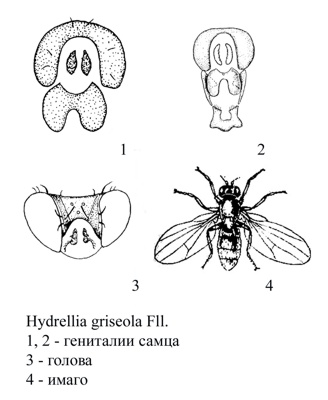Pests
Hydrellia griseola Fall. - Smaller Rice Leaf Miner.
Systematic position.
Class Insecta, order Diptera, family Ephydridae, subfamily Hydrellinae, genus Hydrellia.Biological group.
Pest of cereals.Morphology and biology.
The fly is ash-gray with light bronze shade, 2.5-3 mm in size. Small head bears large red, hairy eyes. There is a well distinguished lunule over the antennae base, colored with silvery-gray or yellow, as well as the face. There are two pairs of orbital chaetae on the head and 1-3 pairs of large dorsocentral chaetae on the thorax. Mesothorax and abdomen are dim, covered with a thick pollination. Wings do not bear dark spots. The second section of the costal vein is almost two times as long as the third one. Subanal plate of the male has a deep groove occupying more than a half of its length. Reliable species identification is only possible based upon the male genitals. The egg is white, elongated, 0.5-0.6 mm in length and 0.2 mm in width. The chorion is furrowed lengthwise. The Miner lays eggs on the upper side of leaves of sprouts of cereal crops and weeds. The highest number of eggs may be found on the floating leaves of rice. There are 1 to 3 eggs in an egg batch, maximum 26. Eggs develop 5-6 days. Right after the hatching, larva penetrates the leaf and destroys its parenchyma, forming a mine. The mine begins from the egg batch location as a narrow band and runs along the main vein. Occasionally, the larva makes loops and forms a bubble-like mine in the area of pupation. The larva is initially transparent-whitish and then becomes yellow-whitish with a clearly seen oropharyngeal apparatus. The larva has three instars. The first instar larva is 1 mm in size, the third is 3.6 mm; it pupates in the mine or in the soil. The pupa is located in an elongated (3.4-3.7 mm) light brown pseudococoon. The pupal stage lasts for 2 weeks and part of pupae diapauses. Puparia or imagoes hibernate in the soil. Flies emerge in the beginning or end of May, when cereal crops are in the stage of 1-2 leaves. In a few days (at temperature 17°C), the flies start laying eggs. If the egg batch consists of one egg, the leaf survives. In case of several eggs in a batch, the larvae damage it hard and it perishes. If the period of the egg laying is extended, all the stages can be found on the crops simultaneously. The larva develops 2-3 weeks. If there are 10-15 larvae on one leaf, they transit to another leaf or may even change plants.Distribution.
The pest is ubiquitous. It is harmful in Baltic countries, in Ukraine, in Kazakhstan, in wet regions of middle and northern Russia, in the Far East and Siberia. In Primorskii Territory, it is the most abundant and widely distributed rice pest, with outbreaks every year.Ecology.
The pest develops on wheat, barley, rice, maize, and timothy. It has two generations, having a third generation in Kuban and the fourth one in Primorskii Territory. It is clearly hydrophilic, as additional feeding of imago, mating and egg-laying are performed on the water surface of rice fields or in the near-water layer of plants. Insect density is regulated by Habrobracon spp., which destroy an average 5-10% puparia of the pest.Economic significance.
The larvae feed on the leaf parenchyma, causing reduction of plant photosynthesis intensity and of crop yield. The harmfulness is observed on the cereal crops and weeds that are adapted to higher and normal humidity. Upon 14-16% damage of the leaf surface by the Small Rice Leaf Miner, rice yield is decreased by 6-9%. To control the Small Rice Leaf Miner, a complex approach combining agronomical and chemical methods is used. The under-winter plowing, seed material of good quality, optimal dates of sowing, correct application of fertilizers and weed control are of great importance. Pesticides are used in the period of sprouting at the phase of 1-3 leaves, when flies migrate to the crops and larvae emerge. Spatial isolation (2 km) of the new year crop from the plots of the previous year crop is recommended. Right after the harvest, the stubbling and in 15-18 days the under-winter plowing should be done at the depth of 27 cm.Reference citations:
Bei-Bienko G.Ya., ed. 1970. Keys to insects of the European part of USSR. V. 5(2). Leningrad: Nauka. p. 363-388 (in Russian).Kas'yanov A.I. 1967. Dipteran pests of rice. Zashchita rastenii 9: 33-34 (in Russian).
Kazanok G.T. 1984. Pests of rice in Ukraine. In: Vasil.ev V.P., ed. 9th All-Union Entomol. Soc. Congr. Abstr. Kiev: Naukova dumka. p. 204-205 (in Russian).
Klimanova N.K. 1971. Species composition of miners damaging rice in Primorskii Territory. In: Serov K.A., ed. Increasing efficacy of agricultural production. Proceedings of Primorskii Agricultural Institute. Ulan-Ude: Buryatian Agricultural Institute. V. 13(1): 34-37 (in Russian).
Klimanova N.K. 1971. Miners on rice. Zashchita rastenii 4: 33-34 (in Russian).
Kotlyarova L.A. 1987. Biological method for rice protection. In: Scientific bases for rice production in Kazakhstan. p. 102-108 (in Russian).
Ler P.A., ed. 2001. Keys to insects of Far East of Russia. V. 6(2). Vladivostok: Dal'nauka. p. 182-210 (in Russian).
Loginova K.M. 1963. Smaller Rice Leaf Miner on maize. Zashchita rastenii ot vreditelei i boleznei 9: 56-57 (in Russian).


